Toddler Garden in Brooklyn

Some evidence of maturity in the small Brooklyn garden belies its true age--only 16 months since planting started, merely a toddler garden. I wonder if I'm in for a bout of the "terrible twos."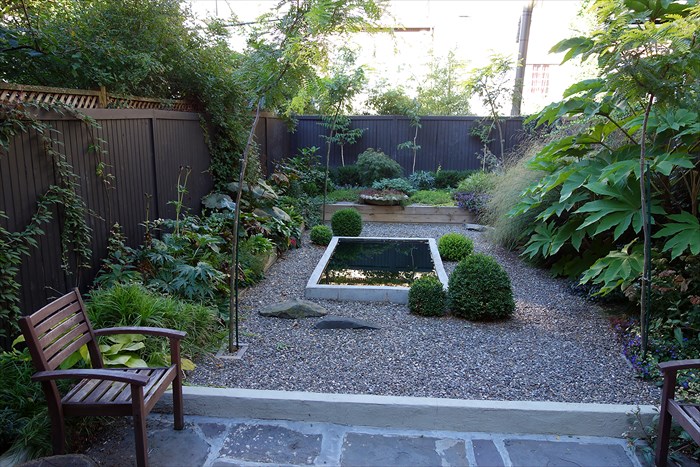 Now that we've moved into the latter half of September and autumn is just around the corner, I think this is a good time to evaluate some of the plantings. The shady side (below) still retains foliage interest, with a diverse mixture of shapes, structures, and colors. Some of the plants with larger leaves--Astilboides tabularis, Darmera peltata, Ligularia japonica--look much better at a distance. Their leaf tissues are delicate and, although extraordinarily sensuous in spring and most of the summer, they take on a beaten look by late summer and fall. They don't stand the summer heat well, at least in the city, even though they are almost entirely in shade. I need to seek out probably two other plants that retain a more youthful look into the fall. I'm thinking a large form of equisetum might be interesting.
Now that we've moved into the latter half of September and autumn is just around the corner, I think this is a good time to evaluate some of the plantings. The shady side (below) still retains foliage interest, with a diverse mixture of shapes, structures, and colors. Some of the plants with larger leaves--Astilboides tabularis, Darmera peltata, Ligularia japonica--look much better at a distance. Their leaf tissues are delicate and, although extraordinarily sensuous in spring and most of the summer, they take on a beaten look by late summer and fall. They don't stand the summer heat well, at least in the city, even though they are almost entirely in shade. I need to seek out probably two other plants that retain a more youthful look into the fall. I'm thinking a large form of equisetum might be interesting.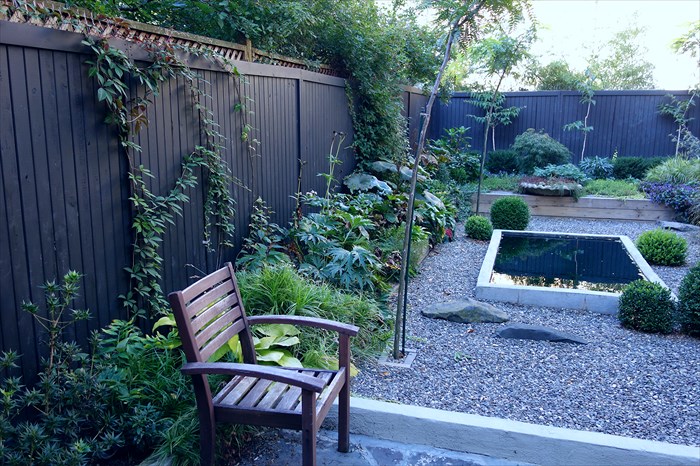 On the other hand, the plants on the sunny side are thriving. The black bamboo (r to l), Persicaria 'Red Dragon', Cotinus coggygria 'Royal Purple', Tetrapanax papyrifera 'Steroidal Giant', Panicum 'Cloud 9', and (hidden) bronze fennel and Pycnanthemum muticum (Mountain mint) have held up very well through the stress of summer heat and are in active growth still. They're crowded, though (this might be the "terrible twos"), so some changes are in store for next spring.
On the other hand, the plants on the sunny side are thriving. The black bamboo (r to l), Persicaria 'Red Dragon', Cotinus coggygria 'Royal Purple', Tetrapanax papyrifera 'Steroidal Giant', Panicum 'Cloud 9', and (hidden) bronze fennel and Pycnanthemum muticum (Mountain mint) have held up very well through the stress of summer heat and are in active growth still. They're crowded, though (this might be the "terrible twos"), so some changes are in store for next spring.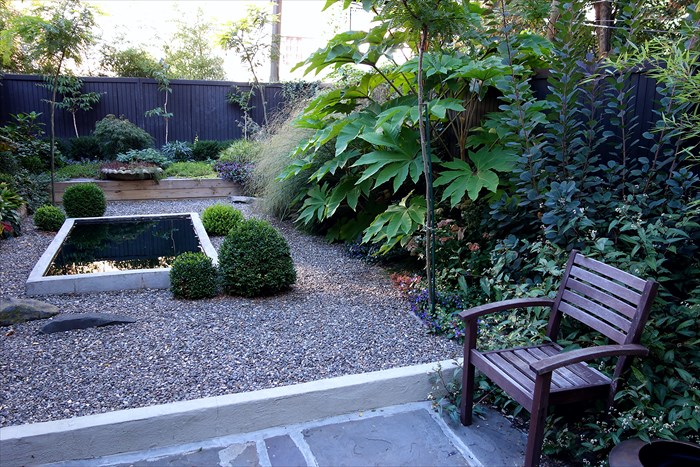 I still want to stain the timbers used for terracing, but I'm undecided about color. The slate of the back wall or a lighter color closer to that of the gravel? I suppose I'll have to try both, then decide.
I still want to stain the timbers used for terracing, but I'm undecided about color. The slate of the back wall or a lighter color closer to that of the gravel? I suppose I'll have to try both, then decide.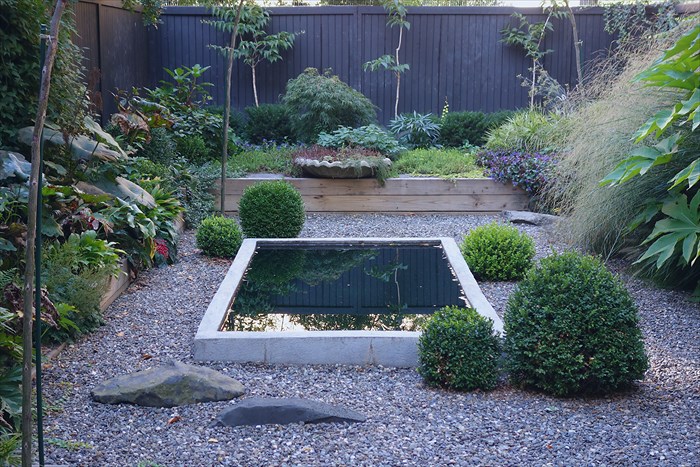 The reflection in the pool on a cool, sunny morning ... I have no qualms about this. The pool dominates the garden, and will remain as it is.
The reflection in the pool on a cool, sunny morning ... I have no qualms about this. The pool dominates the garden, and will remain as it is. Some of the smaller plantings are doing well. Tumbling over the low wall here is a late star, Ceratostigma plumbagenoides (plumbago) flowering in brilliant blue in bright sun (it almost seems to vibrate) and it continues very late, then the foliage turns an exciting red. The Carex muskingumensis 'Oehme' to its left adds a pleasant contrast in color and form. The sedum isn't as pink as it looks here (my camera seems to amplify some colors). Behind is a 'Snowflake' Hydrangea quercifolia, which will add greatly to the massing of large foliage at the back corners of the garden in a few years, and should push out those endlessly remontant, drooping flowers.
Some of the smaller plantings are doing well. Tumbling over the low wall here is a late star, Ceratostigma plumbagenoides (plumbago) flowering in brilliant blue in bright sun (it almost seems to vibrate) and it continues very late, then the foliage turns an exciting red. The Carex muskingumensis 'Oehme' to its left adds a pleasant contrast in color and form. The sedum isn't as pink as it looks here (my camera seems to amplify some colors). Behind is a 'Snowflake' Hydrangea quercifolia, which will add greatly to the massing of large foliage at the back corners of the garden in a few years, and should push out those endlessly remontant, drooping flowers. The Panicum 'Cloud 9' is an interesting contrast to the huge leaves of the Tetrapanax. I'll tie it back soon to give it a vertical lift. I do like this bit of the prairie in Brooklyn and hope I don't have to give up its space. I've decided not to mulch and wrap the Tetrapanax this winter in hope the cold will kill back some, or all, of the top growth without killing the plant entirely. A risk but, I think, a necessary one.
The Panicum 'Cloud 9' is an interesting contrast to the huge leaves of the Tetrapanax. I'll tie it back soon to give it a vertical lift. I do like this bit of the prairie in Brooklyn and hope I don't have to give up its space. I've decided not to mulch and wrap the Tetrapanax this winter in hope the cold will kill back some, or all, of the top growth without killing the plant entirely. A risk but, I think, a necessary one.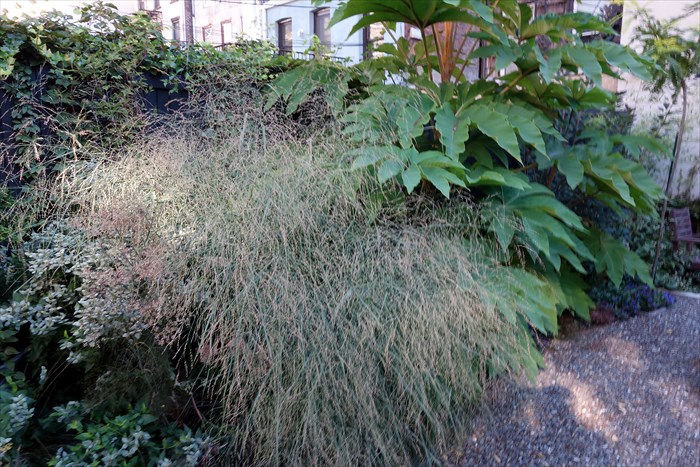 More plumbago creeping out around the base of one of the four Sunburst Honey locusts.
More plumbago creeping out around the base of one of the four Sunburst Honey locusts. The garden seating, which should have been stained the color of the fence, but I've been too busy with the Federal Twist garden. The watering hose lives in the metal bowl.
The garden seating, which should have been stained the color of the fence, but I've been too busy with the Federal Twist garden. The watering hose lives in the metal bowl.
